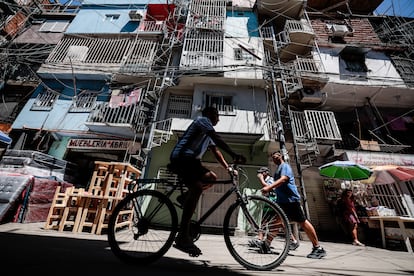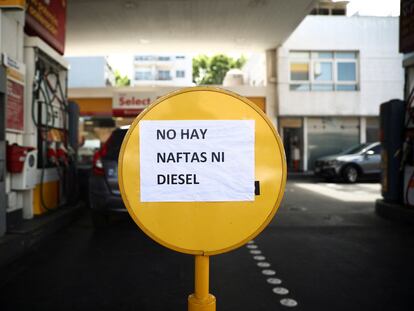The daunting economic landscape choking Argentine voters
The winning presidential candidate on November 19 will inherit a country with a stagnant economy, inflation over 142%, a 40% poverty rate, and minimal reserves

Argentina is heading into the presidential runoff on November 19 with a rapidly declining economy. The country’s Gross Domestic Product (GDP) has remained stagnant for the past three months, while inflation has skyrocketed to over 142% since last year. A quarter of the population lives in poverty, and parents who each earn the minimum wage can’t cover basic household expenses for a family of four. The foreign exchange market is muddled by multiple dollar exchange rates, and the Central Bank’s reserves have been cut in half over the last four years. On top of all this, Argentina is burdened with a $44 billion debt to the International Monetary Fund (IMF). Argentines are hopeful that their next president will bring an end to their struggles, but the two candidates have radically different approaches. One is an economist who promises to take a chainsaw to the public budget, and the other is the current Minister of Economy with a more cautious plan.
The Peronist coalition candidate, Sergio Massa, has been in charge of managing the economy for about a year, and many wonder what he will do differently as president. The Peronist coalition blames the deepening crisis on a historic drought that has led to $20 billion in losses. They also cite the impact of the pandemic and the IMF debt assumed by former president Mauricio Macri. Ultra-libertarian Javier Milei blames the crisis on a fiscal policy of excessive money creation and has proposed dollarizing the economy to tackle rampant inflation. He also wants to radically cut public spending. Economists all over the world have criticized Milei’s ideas as dangerous for Argentina.
Gross Domestic Product
The GDP of the second-largest South American economy declined by 4.9% in the second quarter of 2023 compared to the same period last year. Argentina’s economy has been stagnant for many years, and only saw growth in 2013, 2015 and 2017. In other years, the economy actually contracted. During President Alberto Fernández’s first year in office (which coincided with the start of the pandemic), GDP dropped by 9.9%. In 2021, GDP rebounded briefly and then began to sink again. According to an IMF report, the country’s $22,000 per capita GDP in 2022 is 9% lower than it was a decade ago.
Inflation
The monthly Consumer Price Index (CPI) provides the country with information about inflation and the erosion of their purchasing power. In October, the inflation rate rose by 8.3% over September and reached a record 142.7%, the highest rate in 30 years. In South America, only Venezuela has a higher inflation rate than Argentina. In 2015, when Mauricio Macri became president, inflation stood at 25%. By the time he left office four years later, it had doubled to 54%. Today, the inflation rate has nearly tripled, and unofficial forecasts indicate it will spike to 185% by the end of the year.
Poverty
Four in 10 Argentines live in poverty, according to the National Institute of Statistics and Censuses (INDEC). Poverty increased during the Macri (2015-2019) and Fernández administrations. The latest poverty data for the second half of 2023 indicates that it’s the highest since early 2021, after a year of pandemic. The poverty rate is even worse among the country’s youth, with 56% of people under 15 living in poverty, and 9.3% of the population doesn’t earn enough to buy food. With a minimum wage of 146,000 pesos ($415 at current exchange rates) in November, twice that amount is insufficient to cover basic needs (food, transportation, clothing, etc.) for a household with two adults and two minors.
Unemployment
The unemployment rate has improved in Argentina, but the country has a precarious labor market with falling wages due to inflation. President Fernández took office with an 8.9% unemployment rate, which decreased to 6.2% in the second quarter of 2023 according to INDEC. Young people aged 14-29 were most affected, with unemployment rates of 13.4% for women and 12.3% for men. Unlike previous quarters, the recent drop in unemployment was due to fewer jobseekers and not an increase in the number of jobs, which remained flat.
Peso exchange rates
The parity between the Argentine peso and the U.S. dollar came to an end after the 2002 “corralito” banking crisis, when the government imposed limits on cash withdrawals to prevent a bank run. Prior to this, there was a legally fixed exchange rate. Today, there are multiple exchange rates in Argentina due to tightened exchange restrictions since 2011. Back then, the dollar was pegged to 4.3 pesos, while the unofficial “blue dollar” traded for 4.6 pesos on the street.
By the time Fernández took office in December 2019, the exchange rate was 62 pesos per dollar. It’s now 369 pesos per dollar, after being fixed at 365 for three months. The gap between the official and unofficial exchange rates is now greater than 160%, with a street value of 950 pesos for one blue dollar.
Central Bank reserves
The government has tried to prop up the peso by intervening in the foreign exchange market, which has depleted the Central Bank’s limited foreign reserves. Gross reserves have declined by 53% in the past year, down to $20.9 billion, according to the Central Bank. But other economists who have analyzed the country’s net reserves (the readily available foreign currency held by the Central Bank) tell a different story, although the Central Bank disputes their estimates. When Fernández took office, the Central Bank’s reserves were estimated at $12 billion. Four years later, these experts say the country has a $10 billion deficit in foreign reserves. Argentina has long suffered from a chronic foreign currency deficit, exacerbated in 2023 by a severe drought that severely affected the agricultural sector, which accounts for 70% of the country’s foreign currency inflows.
Sign up for our weekly newsletter to get more English-language news coverage from EL PAÍS USA Edition
Tu suscripción se está usando en otro dispositivo
¿Quieres añadir otro usuario a tu suscripción?
Si continúas leyendo en este dispositivo, no se podrá leer en el otro.
FlechaTu suscripción se está usando en otro dispositivo y solo puedes acceder a EL PAÍS desde un dispositivo a la vez.
Si quieres compartir tu cuenta, cambia tu suscripción a la modalidad Premium, así podrás añadir otro usuario. Cada uno accederá con su propia cuenta de email, lo que os permitirá personalizar vuestra experiencia en EL PAÍS.
¿Tienes una suscripción de empresa? Accede aquí para contratar más cuentas.
En el caso de no saber quién está usando tu cuenta, te recomendamos cambiar tu contraseña aquí.
Si decides continuar compartiendo tu cuenta, este mensaje se mostrará en tu dispositivo y en el de la otra persona que está usando tu cuenta de forma indefinida, afectando a tu experiencia de lectura. Puedes consultar aquí los términos y condiciones de la suscripción digital.
More information
Archived In
Últimas noticias
Most viewed
- Sinaloa Cartel war is taking its toll on Los Chapitos
- Oona Chaplin: ‘I told James Cameron that I was living in a treehouse and starting a permaculture project with a friend’
- Reinhard Genzel, Nobel laureate in physics: ‘One-minute videos will never give you the truth’
- Why the price of coffee has skyrocketed: from Brazilian plantations to specialty coffee houses
- Silver prices are going crazy: This is what’s fueling the rally










































